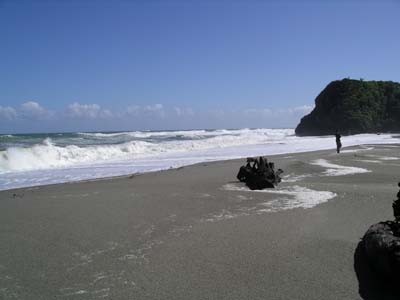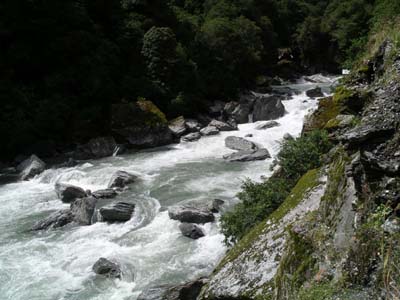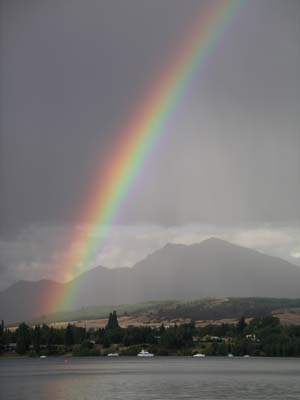Monday, January 19

Paula: Before leaving The Wilderness Lodge at Lake Moeraki we took once last
nature  walk
into the rainforest with our guide, Swade. The destination was a special spot
on the river where large eels are readily lured to the shoreline and can be
fed. We had to try several different tracks before finding one that was passable
- the rains from yesterday had flooded some of the walking trails. Swade had
a bucket of leftover meat and fish scraps and poured some of the broth from
this bucket into the water to attract the eels that live just down stream.
Within a minute we had our first customer - a very large brown trout. The
eels were quick to follow, and within several minutes there were a dozen or
more huge black eels. The trout was mostly interested in bread we had also
brought along and he was not the least bit worried about the eels. The eels
had sharp teeth and lifted
walk
into the rainforest with our guide, Swade. The destination was a special spot
on the river where large eels are readily lured to the shoreline and can be
fed. We had to try several different tracks before finding one that was passable
- the rains from yesterday had flooded some of the walking trails. Swade had
a bucket of leftover meat and fish scraps and poured some of the broth from
this bucket into the water to attract the eels that live just down stream.
Within a minute we had our first customer - a very large brown trout. The
eels were quick to follow, and within several minutes there were a dozen or
more huge black eels. The trout was mostly interested in bread we had also
brought along and he was not the least bit worried about the eels. The eels
had sharp teeth and lifted out of the water to grab the meat and salmon scraps right out of Swade's hands.
They often fought with one another in the water over the scraps, twisting
and turning like crocodiles. We took lots of pictures and even a few movies
especially for Matthew (David & Katie's cousin).
out of the water to grab the meat and salmon scraps right out of Swade's hands.
They often fought with one another in the water over the scraps, twisting
and turning like crocodiles. We took lots of pictures and even a few movies
especially for Matthew (David & Katie's cousin).
 Today
was mostly sunny with only a few clouds remaining from the rains and Nor'wester
of yesterday. We left the lodge heading further south and then eventually
east to Lake Wanaka. The drive took about three hours but the wonderful scenery
made it interesting. As we drove first along the west coast we were able to
watch the still stormy Tasman Sea. At Ships Creek, we decided to take a short
beach walk and found the waves crashing to shore and mixing into the creek,
making thick sea foam all along the beach.
Today
was mostly sunny with only a few clouds remaining from the rains and Nor'wester
of yesterday. We left the lodge heading further south and then eventually
east to Lake Wanaka. The drive took about three hours but the wonderful scenery
made it interesting. As we drove first along the west coast we were able to
watch the still stormy Tasman Sea. At Ships Creek, we decided to take a short
beach walk and found the waves crashing to shore and mixing into the creek,
making thick sea foam all along the beach. 
As we headed back into the Southern Alps and through Haast Pass we stopped
to view the Haast River thundering down under the Gates of Haast Bridge. The
rain from yesterday also enhanced the many waterfalls along the drive including
Fantail  Falls
which was just a five minute walk off the highway. Once through the pass,
the road gradually declined along side the Haast River and there were many
bikers taking advantage of this pleasant drive.
Falls
which was just a five minute walk off the highway. Once through the pass,
the road gradually declined along side the Haast River and there were many
bikers taking advantage of this pleasant drive.
About 50 miles outside of Wanaka, the forested landscape changed to the grasses
and pastures we had observed near Arthur's Pass and we again began seeing
cows and sheep. It wasn't long however, before the huge Lake Wanaka came into
view with a backdrop of still more mountains. 
As we pulled into the town of Wanaka, we finally had reception on our international cell phone and anxiously called home to find out how the Patriots had done in their game against the Colts. Andrew (David & Katie's cousin) enjoyed telling us the good news! The Patriots are headed to the Super Bowl. We've already figured out that we'll be on a boat somewhere on the Great Barrier Reef during the game, so who knows when we'll know the outcome…
 Wanaka
is a cute resort town, smaller and quainter than neighboring and better known
Queenstown. Even this relatively small town was an assault on our senses,
since we haven't seen any commercial areas in over a week. The Edgewater Resort
is right on the lake and reminds us of Ocean Edge Resort in Brewster. The
lake is very large and is surrounded by mountains - we have a great view from
our suite. This spot will be perfect for a few days and has plenty of hiking
and fishing, tennis courts, as well as kayaks and mountain bikes for rent.
We won't have any trouble keeping busy. There's also a small pond here with
baby ducks that remind us of Molly (David & Katie's cousin).
Wanaka
is a cute resort town, smaller and quainter than neighboring and better known
Queenstown. Even this relatively small town was an assault on our senses,
since we haven't seen any commercial areas in over a week. The Edgewater Resort
is right on the lake and reminds us of Ocean Edge Resort in Brewster. The
lake is very large and is surrounded by mountains - we have a great view from
our suite. This spot will be perfect for a few days and has plenty of hiking
and fishing, tennis courts, as well as kayaks and mountain bikes for rent.
We won't have any trouble keeping busy. There's also a small pond here with
baby ducks that remind us of Molly (David & Katie's cousin).
This evening we were also treated to a wonderful pair of rainbows that suddenly appeared out our window looking out over Lake Wanaka.


Tomorrow we plan on renting bikes to explore the coast of the lake, and we also hope to do some more hiking in the afternoon.

Katie's Kwick Kwacks: Feeding the Eels. This morning we took a walk to feed some eels by the lake. It was a very cool experience for us. As well as having fun looking at the eels as they came up to us, we also learned some interesting facts about these ocean snakes and how they survive in the area's moist conditions. We learned that eels have hardly any predators here at Lake Moeraki, the only exception being a single seal which is said to have wiped out a third of the eels and trout at the lake. The ones we fed were very large, but we also saw a few ducks eating some of the baby eels at the lodge. We learned that most species of eels grow to be a little less than three feet; however some species found in the ocean are also known to be nine feet long. The eels feed on dead sea creatures and trout, and sometimes even baby eels. Their skin is covered in slippery mucus, but we noticed from touching them that it felt pretty silky. They have sharp teeth which grow inward, allowing them to scrape meat and flesh off of an animal's skin. They have small blue slits for eyes, but we learned that their sight is very poor. They use their strong sense of smell to track down food. If necessary, they can survive on land for a period of time. We heard that some of the guests at the lodge saw eels crossing over land and into another water source. As you can see, eels are some very interesting creatures and we had a great time learning about them as they slithered and squirmed around in front of us.
David's Daily Dumps: The Maori Culture. The Maori were the first people to inhabit New Zealand. Their culture is extremely unique and extensive. I recently read a book titled, "Whale Rider" which was about a young Maori girl growing up in New Zealand. The Maori first settled on the North Island in 1200 A.D, and then slowly moved to the South island years later. Fifteen percent of the population in New Zealand is of Maori descent. Today, 95% of all Maori live on the North Island, and settle in major cities such as Auckland or Wellington. The Maori people lived in separate tribes or "iwi" throughout the islands. Men and women both had separate jobs; men hunted and plowed, while woman wove, cooked, and gathered roots. The Maori also specialized in poetry, tattooing, and carving. Tribes ate accordingly to their environment. For example, fish was a staple for tribes that lived on the coast while tribes that lived in areas with fertile soil grew and lived off of sweet potatoes. Although each Maori tribe was relatively different, they all shared the same gods. There were gods for everything: the sky, ocean, forests, and even farming. The supreme god, Io, was worshipped by chiefs, and not known to exist by the rest of the community. They also shared certain concepts such as life force, sorcery, revenge and war. In 1838, the British and Maori signed The Treaty of Waitangi, which made New Zealand a British colony, and said that the Maori could only sell their land to Britain. Unfortunately, when the colonists came to settle New Zealand, the Maori didn't want to sell their land, and went to war with Britain. The Maori were easily defeated and lost almost all their land.
